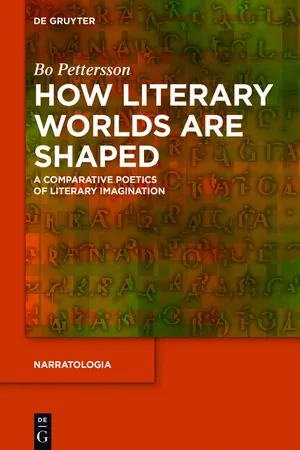
How Literary Worlds Are Shaped
A Comparative Poetics of Literary Imagination
- 334 pages
- English
- PDF
- Available on iOS & Android
About this book
Literary studies still lack an extensive comparative analysis of different kinds of literature, including ancient and non-Western. How Literary Worlds Are Shaped. A Comparative Poetics of Literary Imagination aims to provide such a study. Literature, it claims, is based on individual and shared human imagination, which creates literary worlds that blend the real and the fantastic, mimesis and genre, often modulated by different kinds of unreliability. The main building blocks of literary worlds are their oral, visual and written modes and three themes: challenge, perception and relation. They are blended and inflected in different ways by combinations of narratives and figures, indirection, thwarted aspirations, meta-usages, hypothetical action as well as hierarchies and blends of genres and text types. Moreover, literary worlds are not only constructed by humans but also shape their lives and reinforce their sense of wonder. Finally, ten reasons are given in order to show how this comparative view can be of use in literary studies. In sum, How Literary Worlds Are Shaped is the first study to present a wide-ranging and detailed comparative account of the makings of literary worlds.
Frequently asked questions
- Essential is ideal for learners and professionals who enjoy exploring a wide range of subjects. Access the Essential Library with 800,000+ trusted titles and best-sellers across business, personal growth, and the humanities. Includes unlimited reading time and Standard Read Aloud voice.
- Complete: Perfect for advanced learners and researchers needing full, unrestricted access. Unlock 1.4M+ books across hundreds of subjects, including academic and specialized titles. The Complete Plan also includes advanced features like Premium Read Aloud and Research Assistant.
Please note we cannot support devices running on iOS 13 and Android 7 or earlier. Learn more about using the app.
Information
Table of contents
- Contents
- Introduction
- 1 Imaginative World-Making
- 2 The Imaginative Uses of Mimesis
- 3 Kinds of Unreliability
- 4 The Shaping of Literary Worlds
- 5 Key Combinations: Figures and Narratives
- 6 Other Imaginative Inflections
- 7 How Literary Worlds Shape Us
- 8 Why Literature Matters
- 9 Ten Reasons to Study and Teach Literary Worlds
- Conclusion
- Appendix 1
- Appendix 2
- Bibliography
- Index